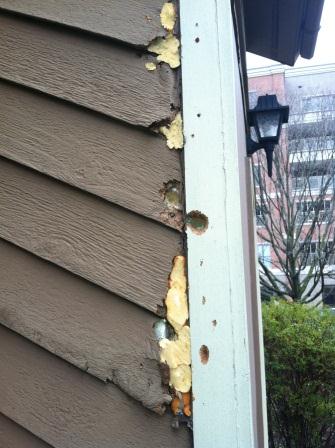Woodpecker Removal
Woodpecker Removal
Woodpeckers drum for three reasons: to attract a mate, to advertise the boundaries of their territory, and to forage for food. If for whatever reason they have decided to do so on your home they’re probably driving you crazy! What’s worse, they’re also causing costly damage to your soffits and siding. If left alone long enough they will hollow out a hole for nesting. These nesting holes not only provide extra habitat to support more woodpeckers, but can easily be utilized by rodents and squirrels. This problem is complicated further by the fact that all woodpeckers in North America are protected under the Migratory Bird Treaty Act of 1918. This statute protects not just the birds themselves but their nests, eggs, and even their feathers. In fact, the top suggestion from the NYS DEC to handle a problem such as this is to live with the noise. Our suggestion is to act quickly before the problem gets out of hand.
Woodpecker Control
Many woodpecker issues can be resolved with a simple repellant. We apply a thin layer of a sticky liquid repellant that mimics pine or maple sap. On average birds spend upwards of 30% of their day preening their feathers, and as such they cannot afford to have any sticky substance on their bill or feet as it will greatly affect their ability to withstand wind and rain, as well as their ability to fly. Once woodpeckers associate your house with this repellant, they’ll assume it’s a large, square pine tree and the danger of getting covered in sap is enough to turn them away. One application is usually enough to deter woodpeckers from most areas. We guarantee each application for 1 year, so if follow up visits are required, it’s free of charge. After 1 year, however; the repellant begins to dry and deteriorate, therefore requiring annual reapplication for recurring issues.
Get Rid of Woodpeckers From Damaging Your House
The next step is to patch all the holes and fix the damage as soon as possible. Open woodpecker holes invite curious passersby and can also soak up water and encourage rot. If the problem is caught soon enough, some wood putty and fresh paint may be all that’s needed. In some cases, more complicated problems may require replacement of affected building materials. Houses with cedar or other types of wood siding, especially when painted or stained natural colors like brown or green, tend to be more commonly affected. Some materials like modern composites; however, are more resistant to damage from drumming and do not resonate like wood making them less appealing to woodpeckers. With tough modern materials and a little ingenuity you can be sure you’re taking the most proactive approach possible to a very tricky problem.



